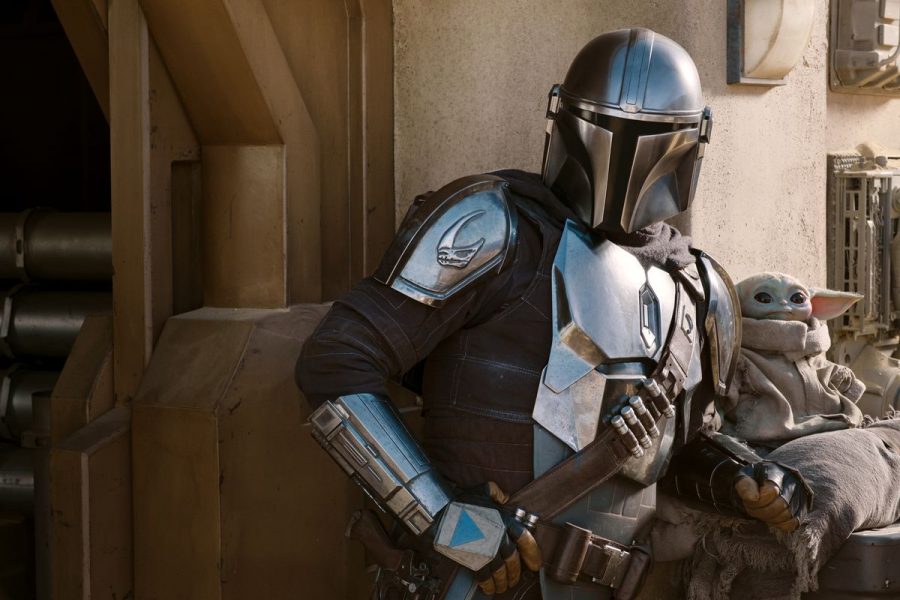“The Mandalorian” returns for Season 2 and foreshadows the future of “Star Wars”
Baby Yoda is back, along with his Boba Fett-esque protector, for another season of “The Mandalorian,” in a new episode that aims to please.
The Baby Yoda Show is back! And by that, I, of course, mean the hit live-action “Star Wars” spin-off series, “The Mandalorian,” that has dominated pop culture conversation since its premiere in November 2019. Set between the original trilogy and the recent sequel trilogy, the series is entrenched in “Star Wars” lore and iconography, and with a smaller scale in comparison to the bombastic films, “Mandalorian” has felt unique and remains steeped in the tropes of classic Westerns.
As the flagship series of Disney’s immensely successful streaming series Disney+, “The Mandalorian” focused on the exploits of a bounty hunter as he travels alongside “The Child,”––a force-sensitive bounty that he was supposed to turn in. Fans have lovingly dubbed the tiny character, “Baby Yoda,” as it seems to be an infant in the same species as Jedi Master Yoda from the original film series.
At the end of the first season, “Mando” had completely bonded with Baby Yoda, and after finding out that it has magic powers and is “force-sensitive,” he decides to protect it from the decaying Galactic Empire and reunite it with its own kind. Though that overarching plot was enticing enough, the true charm of “The Mandalorian” was found in its anthology format, with each episode featuring an “adventure-of-the-week” flavor that placed our favorite bounty hunter and goofy baby duo through new scenarios and side-plots as the season built to the finale.
The first episode of the second season, which released Friday, Oct. 30, picks up with the same laid-back tone, but as new episodes come out weekly, the scope for this season could be far beyond the first. The episode is another small-scale adventure following Mando’s quest to reunite Baby Yoda with its kind––leading him to scenarios straight out of western movies like “The Good, The Bad and The Ugly” and “The Magnificent Seven,” as he returns to the fan-favorite planet of Tatooine.
There, he strolls into a mining town on the edge of civilization that is protected by “Marshall” Cobb Vanth, who has somehow recovered the armor of Boba Fett, the iconic bounty hunter who seemingly fell to his death in “Star Wars: Episode VI – Return of the Jedi.” The pair team up, along with the Tusken Raiders, to fight off the Crayt Dragon, a giant beast that endangers them all. The Tusken Raiders, or the “sand people,” as they are known, had been previously depicted as barbaric and more akin to animals, so it was interesting to see them in a more humanizing scenario. Mando highlights their culture by actually communicating with them and allowing them to show how their warrior-based society operates, similar to Mandalorians themselves in a way.
Together, the gang comes together for a set-piece unlike any other seen in “Star Wars” media, with deliberate pacing, planning and execution. The level of quality, along with a reveal of a fan-favorite character at the end, makes this season very exciting and possibly indicates a greater integration with the “Star Wars” canon than before. That last part may or may not be a good thing.
“The Mandalorian” has been at its best the less like “Star Wars” it is, with the understated nature of the series remaining one of its greatest strengths. The “Star Wars” series has had a difficult time breaking out of the confined nature of its intellectual property. The original trilogy is one of the hallmarks of American culture, but mostly because it’s a sci-fi reinvention of classic fantasy tropes, with iconic characters, iconic set design and iconic grandiose music that has allowed the trilogy to succeed and take root, rather than the actual richness of the plot and lore.
Since then, the rest of the series has been built on nostalgia for the originals, with some interesting additions to the canon coming along the way. Most notably, the recent sequel trilogy, comprising Episodes VII, VIII and IX, has been criticized for relying too much on the tropes and structure of the original trilogy, with Episode IX especially maligned for playing it too safe. (I still enjoyed the entire trilogy.) However, “The Mandalorian” has been a palette cleanser for many, giving a new take on “Star Wars” less reliant on the massive space-dogfights and classic battles between good and evil, and creating its own niche.
As the weekly episodes roll out, the story will continue to unfurl, but all indicators show that the series will become more far integrated with the overall “Star Wars” story, with many characters from across the series slated to return. As that happens, could the series lose the charm that made it so popular? That remains to be seen, but as of now, the second season is starting off strong with authentic western vibes and cute new Baby Yoda gifs and memes.
What more can you ask for?

Shreyas (he/him) is a fourth-year student majoring in biology and philosophy. If he isn't yammering to you about how great "Pet Sounds" is or making bad...


